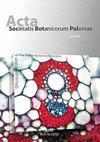Effects of zinc oxide nanoparticles on enzymatic and nonenzymatic antioxidant content, germination, and biochemical and ultrastructural cell characteristics of Portulaca oleracea L.
IF 0.8
4区 生物学
Q3 PLANT SCIENCES
引用次数: 19
Abstract
This report focuses on the application of zinc oxide nanoparticles (ZnO NPs) carrying phycomolecule ligands as a novel plant growth promoter aimed at increasing the crop productivity of purslane ( Portulaca oleracea L.). Experiments were performed under controlled greenhouse conditions using a completely randomized design with nine replications. Purslane seeds were treated with four concentrations of ZnO NPs (0, 10, 100, and 500 mg L −1 ) and four concentrations of bulk ZnO (0, 10, 100, and 500 mg L −1 ). The ultrastructural characteristics of the leaves of the plants treated with of 500 mg L −1 ZnO NPs were determined using transmission electron microscopy (TEM). The results indicated that the treatment with ZnO NPs increased the content of chlorophyll a and chlorophyll b , carotenoids, and total phenolic and flavonoid compounds significantly more than the treatment with bulk ZnO. Our findings also showed that the application of high concentrations of ZnO NPs is the most effective strategy to considerably induce the antioxidant capacity and enzymes of purslane plants. Furthermore, the seed germination percentage and sprout growth rates were significantly higher in the plants treated with 500 mg L −1 of ZnO NPs (100% ±0.00), compared to the control plants (93.33% ±1.66). The TEM images revealed the concentration of ZnO NPs and cell membrane rupture, as well as a deformation in the shape of chloroplasts and a decrease in their number in the plants treated with 500 mg L −1 ZnO NPs, compared to the control plants. Owing to their toxicity, high concentrations of ZnO NPs lead to oxidative stress in plants. Thus, our findings provide a new alternative strategy for increasing crop productivity, i.e., the application of ZnO NPs as a novel plant growth booster, in comparison with the bulk ZnO treatment.氧化锌纳米颗粒对马齿苋酶和非酶抗氧化剂含量、发芽、生化和超微结构细胞特性的影响。
本报告重点研究了携带藻分子配体的氧化锌纳米颗粒(ZnO NPs)作为一种新型植物生长促进剂的应用,旨在提高马齿苋(Portulaca oleracea L.)的作物生产力。实验采用完全随机设计,在受控的温室条件下进行,共9次重复。马齿苋种子用四种浓度的ZnO NPs(0、10、100和500 mg L−1)和四种浓度(0、100、500 mg L–1)处理。用透射电子显微镜(TEM)测定了用500 mg L−1 ZnO NPs处理的植物叶片的超微结构特征。结果表明,与大块ZnO处理相比,ZnO NPs处理显著增加了叶绿素a和叶绿素b、类胡萝卜素以及总酚类和黄酮类化合物的含量。我们的研究结果还表明,应用高浓度的ZnO NPs是显著诱导马齿苋植物抗氧化能力和酶的最有效策略。此外,与对照植物(93.33%±1.66)相比,500 mg L-1 ZnO NPs处理的植物的种子发芽率和发芽生长率显著较高(100%±0.00)。TEM图像显示了ZnO NPs的浓度和细胞膜破裂,以及与对照植物相比,用500 mg L−1 ZnO NP处理的植物中叶绿体形状的变形和数量的减少。由于其毒性,高浓度的ZnO NPs会导致植物的氧化应激。因此,我们的发现为提高作物生产力提供了一种新的替代策略,即与大块ZnO处理相比,应用ZnO NPs作为一种新型的植物生长促进剂。
本文章由计算机程序翻译,如有差异,请以英文原文为准。
求助全文
约1分钟内获得全文
求助全文
来源期刊
CiteScore
2.00
自引率
10.00%
发文量
18
审稿时长
1 months
期刊介绍:
The journal has been published since 1923 and offers Open Access publication of original research papers, short communications, and reviews in all areas of plant science, including evolution, ecology, genetics, plant structure and development, physiology and biochemistry.

 求助内容:
求助内容: 应助结果提醒方式:
应助结果提醒方式:


